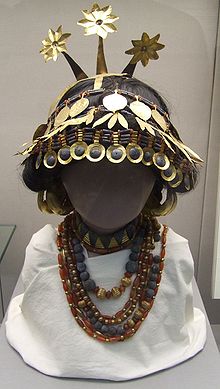Puabi
Puabi (also Schubad ) was a Sumerian queen or lady-in-waiting who was buried in the royal cemetery of Ur . She lived around 2500 BC. Chr.
Puabi was entitled NIN (or EREŠ), which actually cannot be translated as queen , so her real status must remain open.
The tomb of the Puabi (No. 800) was not robbed. A cylinder seal bore the name of the Puabi. In the burial chamber the Puabi skeleton lay on a stretcher with its head facing west and its hands on its stomach. She wore a golden headdress. Her wig was probably on her left. A diadem richly decorated with golden animal figures has been preserved here. Three other skeletons were also buried. After examining the skeleton, Puabi was around 40 years old. The burial chamber also contained a threshing slide and lots of ceramics.
A shaft was found near the burial chamber in which five soldiers and 23 servants were buried. A chest in this shaft contained valuable accessories, such as gold and silver vessels. Woolley initially assumed that this shaft belonged to the tomb of the Puabi, but this is more doubtful today, since the tomb and the shaft are close together, but are not structurally connected. The finds were shared between the University of Pennsylvania Museum of Archeology and Anthropology , the British Museum, and the National Museum of Iraq .
literature
- Leonard Woolley : Ur Excavations II, The Royal Cemetery , New York 1934, pp. 73-91.
supporting documents
Web links
| personal data | |
|---|---|
| SURNAME | Puabi |
| ALTERNATIVE NAMES | Drawer |
| BRIEF DESCRIPTION | Sumerian queen |
| DATE OF BIRTH | around 25th century BC Chr. |
| DATE OF DEATH | around 25th century BC Chr. |


